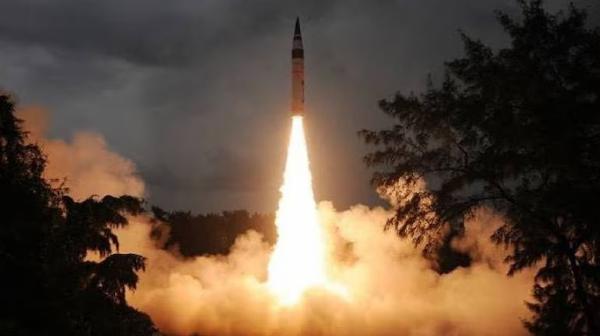
Geopolitics & World-affairs
India joins the elite list of nations with MIRV capable Made-in-India Agni-V
On Monday, Prime Minister Narendra Modi declared the successful launch of the Agni 5 Intercontinental Ballastic Missile with Multiple Independently Targetable Reentry Vehicle (MIRV) technologies. The Prime Minister tweeted to congratulate the Defence Research and Development Organisation (DRDO) and the entire country on the success of the test.
In a tweet (Now "X"), he said, "Proud of our DRDO scientists for Mission Divyastra, the first flight test of indigenously developed Agni-5 missile with Multiple Independently Targetable Re-entry Vehicle (MIRV) technology."
According to reports, the ICBM may deploy numerous warheads in different locations. Sources told ANI that the project director is a woman who has made major contributions.
The operation that launched the ICBM test flight, dubbed "Mission Divyastra," elevated India to the ranks of nations with MIRV capabilities.
In a tweet (Now "X"), he said, "Proud of our DRDO scientists for Mission Divyastra, the first flight test of indigenously developed Agni-5 missile with Multiple Independently Targetable Re-entry Vehicle (MIRV) technology."
According to reports, the ICBM may deploy numerous warheads in different locations. Sources told ANI that the project director is a woman who has made major contributions.
The operation that launched the ICBM test flight, dubbed "Mission Divyastra," elevated India to the ranks of nations with MIRV capabilities.
What is MIRV Technology?
MIRV is a warhead-carrying design capacity for an intercontinental ballistic missile. Such technology made missiles capable of carrying both conventional and nuclear payloads.
Such technology is primarily used for carrying thermonuclear payloads to hit targets at different speeds and on different trajectories. Each MIRV enables nuclear warheads to be launched independently after the primary propulsion stages of the missile have shut down.
The MIRV technology was initially discovered by the United States during the Cold War, when the United States and the Soviet Union were fiercely competing on many issues, including missile technology.
The deployment of MIRV can improve strategic forces' first-strike capability while also providing more target damage for a given thermonuclear weapon. The MIRV reduces the effectiveness of an anti-ballistic missile system based on intercepting individual warheads.
The countries that possess the MIRV technology other than India are Russia, the United States, France, China, and the United Kingdom. The United States, the United Kingdom, and France all have MIRV technology on their submarine-launched ballistic missiles (SLBMs).
Russia currently has both MIRVed ICBMs and SLBMs. China's MIRV technology is included only in Intercontinental Ballastic Missiles. Pakistan is also reported to have MIRV technology, but it is not at the forefront of the globe.
Such technology is primarily used for carrying thermonuclear payloads to hit targets at different speeds and on different trajectories. Each MIRV enables nuclear warheads to be launched independently after the primary propulsion stages of the missile have shut down.
The MIRV technology was initially discovered by the United States during the Cold War, when the United States and the Soviet Union were fiercely competing on many issues, including missile technology.
The deployment of MIRV can improve strategic forces' first-strike capability while also providing more target damage for a given thermonuclear weapon. The MIRV reduces the effectiveness of an anti-ballistic missile system based on intercepting individual warheads.
The countries that possess the MIRV technology other than India are Russia, the United States, France, China, and the United Kingdom. The United States, the United Kingdom, and France all have MIRV technology on their submarine-launched ballistic missiles (SLBMs).
Russia currently has both MIRVed ICBMs and SLBMs. China's MIRV technology is included only in Intercontinental Ballastic Missiles. Pakistan is also reported to have MIRV technology, but it is not at the forefront of the globe.
What is AGNI-V?
AGNI-V is a land-based intercontinental ballistic missile (ICBM) with an estimated range of more than 8,000 kilometres, but an official range of 5,000 kilometres — According to the Government of India. The missile has been developed by Defence Research and Development Organization (DRDO).
It is a three-stage, road-mobile intercontinental ballistic missile powered by canisters and solid fuel. India has developed this missile primarily to enhance India's nuclear deterrence against China.
Senior defence scientist M. Natarajan revealed in 2007 that DRDO was developing an enhanced version of the Agni III known as the Agni-V. This missile allows India to hit anywhere in China and Asia, as well as Eastern Europe and parts of Africa.
On December 15, 2022, SFC successfully conducted the first-night trial of Agni-V from Abdul Kalam Island in Odisha. The test was designed to validate new technologies and equipment on the missile.
It is a three-stage, road-mobile intercontinental ballistic missile powered by canisters and solid fuel. India has developed this missile primarily to enhance India's nuclear deterrence against China.
Senior defence scientist M. Natarajan revealed in 2007 that DRDO was developing an enhanced version of the Agni III known as the Agni-V. This missile allows India to hit anywhere in China and Asia, as well as Eastern Europe and parts of Africa.
On December 15, 2022, SFC successfully conducted the first-night trial of Agni-V from Abdul Kalam Island in Odisha. The test was designed to validate new technologies and equipment on the missile.
0 Comments